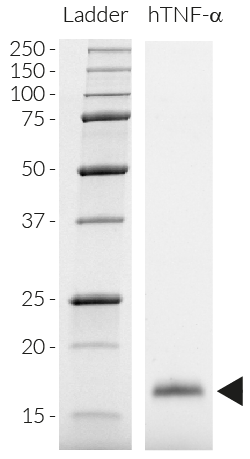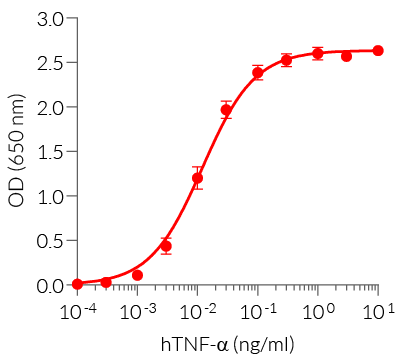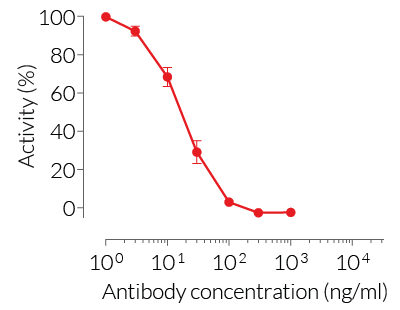Recombinant human TNF-α protein - Bioactive cytokine
| Product | Unit size | Cat. code | Docs. | Qty. | Price | |
|---|---|---|---|---|---|---|
|
Recombinant human TNF-α Recombinant Cytokine, source: CHO |
Show product |
20 µg 5 x 20 µg |
rcyc-htnfa
|
|
Human TNF-α protein - Mammalian cell-expressed, tag-free, with HSA
Recombinant human TNF-α is a high-quality and biologically active cytokine, validated using proprietary TNF-α reporter cells. This pro-inflammatory cytokine of the TNF superfamily is produced in CHO cells to ensure protein glycosylation and bona fide 3D structure.
Recombinant human TNF-α can be used together with HEK-Blue™ TNF-α cells for the screening of inhibitory molecules, such as Adalimumab, a therapeutic monoclonal antibody that targets TNF-α and prevents its binding to its receptor (see figures).
Key features
InvivoGen also offers:
• HEK-Blue™ TNF-α cells
• HEK-Blue-Lucia™ TNF-α cells
• Anti-TNF-α (Adalimumab)
- Each lot is validated using HEK-Blue™ TNF-α cells
- Endotoxin ≤ 0.1 EU/µg
- 0.2 µm sterile-filtered
Applications
- TNF-α detection and quantification assays (positive control)
- Screening and release assays for antibodies blocking TNF-α signaling
- Screening and release assays for engineered TNF-α proteins
Tumor necrosis factor-alpha (TNF-α) is a pleiotropic cytokine that plays a central role in inflammation, cell apoptosis, and immune system development. This potent mediator of inflammation is implicated in the pathogenesis of several autoimmune and inflammatory diseases such as rheumatoid arthritis and inflammatory bowel disease.
InvivoGen’s products are for research use only, and not for clinical or veterinary use.
Back to the topSpecifications
Source: Chinese hamster ovary (CHO) cells
Species: Human
Alternative name: Cachectin, Tumor necrosis factor ligand superfamily member 2
Carrier: HSA (human serum albumin)
Tag: Tag-free
Accession number: P01375
Molecular weight: ~ 17 kDa (SDS-PAGE)
Solubility: 100 μg/ml in water
Formulation: Phosphate buffer saline (pH 7.4), 5% saccharose, 0.1% HSA
Sterility: 0.2 µm filtration
Form: Lyophilized
Reconstitution buffer: Endotoxin-free water (provided)
Purity: ≥97% (SDS-PAGE)
Endotoxin: The absence of bacterial contamination (e.g. lipoproteins and endotoxins) has been confirmed using HEK-Blue™ TLR2 and HEK‑Blue™ TLR4 cells.
Tested applications: Cellular assays
Quality control: Each lot is functionally tested and validated
Back to the topContents
Recombinant human TNF-α is provided as a lyophilized powder and is available in two quantities:
- rcyc-htnfa: 20 µg
- rcyc-htnfa: 100 µg (5 x 20 µg)
- 1.5 ml endotoxin-free water for rcyc-htnfa and rcyc-htnfa-5
![]() Recombinant human TNF-α is shipped at room temperature.
Recombinant human TNF-α is shipped at room temperature.
![]() Upon receipt, the product should be stored at -20°C.
Upon receipt, the product should be stored at -20°C.
![]() Avoid repeated freeze-thaw cycles.
Avoid repeated freeze-thaw cycles.
Details
Tumor necrosis factor-alpha (TNF-α) is a pleiotropic cytokine involved in necrotic and apoptotic cell death, cellular differentiation, inflammation, and regulation of immune cell activity [1]. Notably, deregulated TNF-α production has been implicated in a variety of conditions, including autoimmune and inflammatory diseases [1].
TNF-α is mainly produced by activated monocytes, macrophages, and T cells. It is first synthesized as a membrane-bound molecule that forms a compact homotrimer through non-covalent interactions. The trimeric membrane-bound form is cleaved by tumor necrosis factor-alpha converting enzyme (TACE) releasing the soluble trimer [2]. Both the membrane-bound and soluble TNF-α bind homotrimeric transmembrane receptors, TNFR1 or TNFR2, triggering signaling pathways that involve TRADD, TRAF2, and RIP, and leading to the activation of NF-κB and MAPK pathways.
1. Steeland S. et al., 2018. A new venue of TNF targeting. Int. J. Mol. Sci. 19:1442.
2. Brenner D. et al., 2015. Regulation of tumour necrosis factor signalling: live or let die. Nat Rev Immunol. 15(6):362-74.










